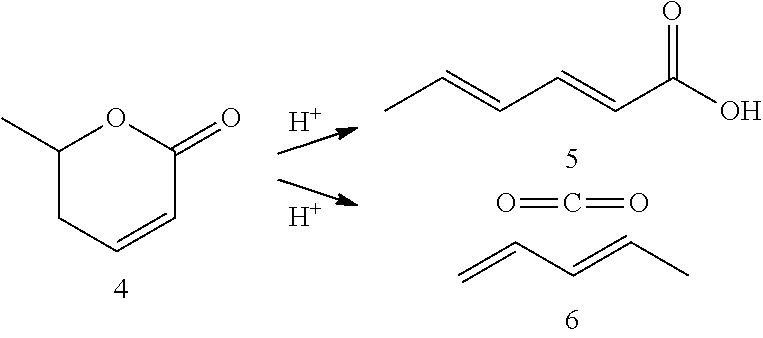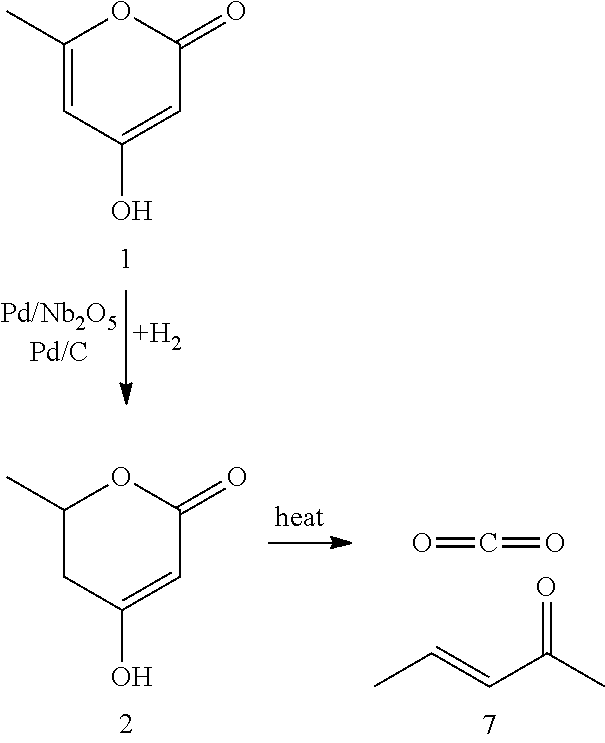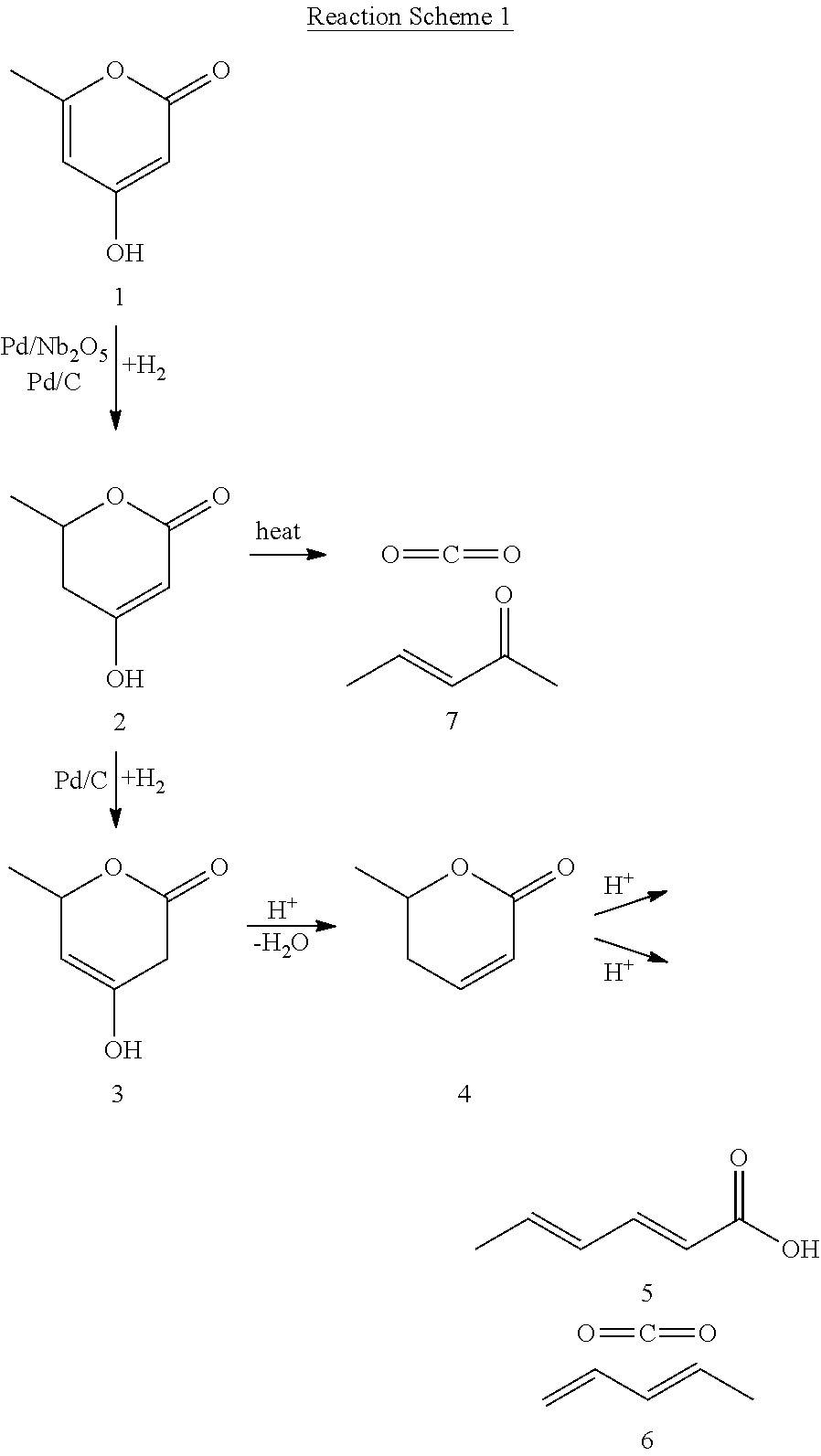Production of 2,4-hexadienoic acid and 1,3-pentadiene from 6-methyl-5,6-dihydro-2-pyrone
a technology of dihydro-2 pyrone and hexadienoic acid, which is applied in the preparation of heterocyclic compounds, hydrocarbon preparation catalysts, carbonyl compounds, etc., can solve the problems of unsatisfactory prior art processes for making sorbates, the required decomposition step is problematic, and the production of 1,3-pentadiene is not known in commercial quantities
- Summary
- Abstract
- Description
- Claims
- Application Information
AI Technical Summary
Benefits of technology
Problems solved by technology
Method used
Image
Examples
example 1
Partial Hydrogenation of 4-Hydroxy-6-methyl-2-pyrone (HMP, 1) to 5,6-Dihydro-4-hydroxy-6-methyl-2H-pyran-2-one (DHHMP, 2)
[0051]Catalyst Preparation: 5 wt % Pd / Nb2O5 was prepared by the incipient wetness impregnation method, using an aqueous solution of Pd(II)NO3 as the precursor. The catalysts were dried at 393 K for 1 h, calcined at 573 K for 5 h in 60 cc (STP) / min flowing air, and then reduced at 623 K for 5 h in 60 cc (STP) / min flowing H2. Finally, the catalyst was passivated with 60 cc (STP) / min flowing 2% O2 in He for 2 h at room temperature.
[0052]Experimental: The reactions were performed in a 50 mL batch reactor (Parr Instruments, Moline, Ill.). 5 wt % Pd / Nb2O5 was used as the catalyst, with 1.8 wt % HMP as the reactant in all cases. The mass ratio of catalyst to HMP was 1:1.7 in all cases. It was found that increased temperature yielded increased product degradation. It was also found that higher H2 pressures caused further hydrogenation of DHHMP to 4-HMTHP and subsequently ...
example 2
Complete Hydrogenation of 4-Hydroxy-6-methyl-2-pyrone (HMP, 1) to 5,6-Dihydro-4-hydroxy-6-methyl-2H-pyran-2-one (4-HMTHP, 3)
[0055]Catalyst preparation: 10 wt % Pd / C (Sigma-Aldrich, Milwaukee, Wis.) was reduced at 533 K for 4 h in 60 cc (STP) / min flowing H2, and then passivated with 60 cc (STP) / min flowing 2% O2 in He for 2 h at room temperature.
[0056]Experimental: The reactions were performed in a 50 mL batch reactor (Parr Instruments). 10 wt % Pd / C was used as the catalyst, with 1.8 wt % HMP as the reactant in all cases. Near-quantitative yield of 4-HMTHP was achieved in all cases, with δ-hexalactone (HL) being the only by-product detected. See Table 2.
[0057]
TABLE 2Complete Hydrogenation of 4-Hydroxy-6-methyl-2-pyrone (HMP, 1) to 5,6-Dihydro-4-hydroxy-6-methyl-2H-pyran-2-one (4-HMTHP, 3) over 10 wt % Pd / C, 323 K.HMPSelectivitySelectivity toCatalyst:HMPPH2Conversionto DHHMP4-HMTHPSelectivity toSolvent(g:g)Time (h)(psi)(%)(%)(%)HL (%)1-Butanol1:1830098099.40.6THF1:16300>990>99Not det...
example 3
Thermal Decomposition of 5,6-Dihydro-4-hydroxy-6-methyl-2H-pyran-2-one (DHHMP, 2) to 3-Penten-2-one (PO, 7)
[0058]Experimental: The decarboxylation of DHHMP (2) to PO (7) was performed in a pressurized (500 psi) upflow reactor, using 2 wt % DHHMP in water as the feed (0.04 mL / min) and He as the carrier gas (14 cc (STP) / min). Decomposition of DHHMP in water was noted to occur across a temperature range of 343-543 K. The molar ratio of CO2 to converted DHHMP was close to 1:1 in all runs. In addition to CO2, PO was the only other product observed. Due to low reactant and product concentrations, and reactant feed rate, the overall carbon balance did not close completely. At 100% conversion of DHHMP, 60% molar yield to PO was noted. Complete results are presented in Table 3.
[0059]
TABLE 3Thermal Decomposition of 5,6-Dihydro-4-hydroxy-6-methyl-2H-pyran-2-one (DHHMP, 2) to 3-Penten-2-one (PO, 7).Yield of POCarbon balanceCO2:DHHMPT (K)(%)(%)converted (mol:mol)49350.157.60.95:145359.766.30.99:...
PUM
| Property | Measurement | Unit |
|---|---|---|
| temperature | aaaaa | aaaaa |
| temperature | aaaaa | aaaaa |
| pressure | aaaaa | aaaaa |
Abstract
Description
Claims
Application Information
 Login to View More
Login to View More - R&D
- Intellectual Property
- Life Sciences
- Materials
- Tech Scout
- Unparalleled Data Quality
- Higher Quality Content
- 60% Fewer Hallucinations
Browse by: Latest US Patents, China's latest patents, Technical Efficacy Thesaurus, Application Domain, Technology Topic, Popular Technical Reports.
© 2025 PatSnap. All rights reserved.Legal|Privacy policy|Modern Slavery Act Transparency Statement|Sitemap|About US| Contact US: help@patsnap.com



